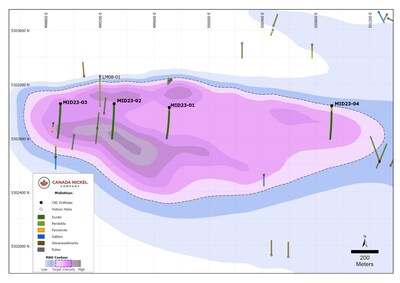Canada Nickel Announces New Nickel Discovery at Midlothian Property with Larger Potential Footprint than Flagship Crawford Property
Rhea-AI Summary
Canada Nickel Company announced positive preliminary drill results from its first four holes at the Midlothian Property, located 70 km south-southeast of Timmins, Ontario. The drilling program, totaling 1,548 meters, intersected significant mineralized dunite over a 2-kilometer strike length. Notably, the preliminary mineralogy samples revealed high concentrations of awaruite (nickel-iron alloy) and brucite, which is crucial for carbon sequestration. The findings indicate that the brucite content exceeds three times that found at the flagship Crawford Project. This discovery adds to Canada Nickel's exploration success in the Timmins Nickel District. The company aims to develop processes for producing net-zero carbon nickel and is evaluating additional drilling programs across its regional portfolio.
Positive
- First four drill holes intersected extensive mineralized dunite over a 2 km strike length.
- Preliminary mineralogy samples indicate significant amounts of recoverable awaruite.
- Brucite content in the samples is more than triple that at Crawford, enhancing carbon sequestration potential.
- Discovery enhances the overall potential of the Midlothian Property compared to Crawford.
Negative
- None.
News Market Reaction 1 Alert
On the day this news was published, CNIKF gained 4.60%, reflecting a moderate positive market reaction.
Data tracked by StockTitan Argus on the day of publication.
Highlights
- First four holes intersected multi-hundred metre intervals of mineralized dunite across a strike length of two kilometres
- Near-surface mineralization - overburden less than five metres thick
- Preliminary mineralogy samples from first two holes confirm:
- mineralization dominated by awaruite, a recoverable nickel-iron alloy mineral
- more than triple Crawford's content of brucite, which is highly reactive for carbon sequestration, in hole MID23-02
The Company has drilled four holes totaling 1,548 metres to complete its initial phase of testing a large geophysical target 2.7 kilometres along strike by up to 800 metres thick and open at depth.
Access to Midlothian is via an all-weather gravel road west from the town of Matachewan. Midlothian is an option agreement between
Historically, a total of 30 holes were drilled over the last 50 years by various operators with 23 holes intersecting serpentinized peridotite/dunite and 17 holes ending while still in the ultramafics. Six drillholes, each intersected over 100 metres of continuous, uninterrupted dunite/ultramafic, with LM08-01 intersecting 263.8 metres to the end of hole. Seven holes had nickel assays, with the best interval in hole LM08-01 which yielded
(see release dated
Four holes were drilled along a strike length of two kilometres, all oriented to the south with an inclination of -50o and maximum length of 400 metres. Overburden in the area varied between 2.0 and 7.7 metres in downhole length (less than 5 metres thick).
MID23-01 was collared toward the centre of the intrusion and intersected 343 metres of highly serpentinized dunite starting at 2.0 metres and ending at 345 metres. Selected samples were taken for metallurgical testing (QEMSCAN) that confirmed the samples were well-serpentinized with varying amounts of heazlewoodite and awaruite. The hole encountered two narrow (~0.5 metres) dikes.
MID23-02 was collared approximately 400 metres west of MID23-01 and intersected a continuous unit of serpentinized dunite below 7.7 metres of overburden to the end of hole at 401 metres. Selected samples were taken for metallurgical testing (QEMSCAN) which confirmed the samples were well-serpentenized and contained awaruite from
MID23-03 was collared approximately 400 metres west of MID23-02, and within 300 metres of the western margin of the ultramafic target. The hole intersected a continuous unit of serpentinized dunite below 5.0 metres of overburden until the end of hole at 401 metres, interrupted only by a 5.5 metre dike.
MID23-04 was collared approximately two kilometres east of MID23-03 and within 400 metres of the eastern margin of the ultramafic target. The hole intersected a sequence of pyroxenite, peridotite and dunite starting at 4.0 metres downhole. This sequence is typically found on the contact of these ultramafic sills. A continuous unit was logged from 80.0 – 401.0 metres as a strongly serpentinized dunite.
Mineral Content (%) | ||||
Hole | Interval (m) | Awaruite | Heazlewoodite | Brucite |
MID23-01 | 27.5-27.6 | 0.00 | 0.29 | 0.74 |
94.5-94.7 | 0.18 | 0.01 | 2.15 | |
146.4-146.5 | 0.16 | 0.00 | 1.18 | |
196.6-196.7 | 0.05 | 0.03 | 2.49 | |
325.8-325.9 | 0.16 | 0.05 | 1.58 | |
MID23-02 | 38.9-39.0 | 0.49 | 0.01 | 9.36 |
108.2-108.4 | 0.46 | 0.00 | 10.91 | |
168.7-168.8 | 0.35 | 0.00 | 9.42 | |
263.0 263.1 | 0.35 | 0.00 | 8.69 | |
Awaruite typically contains
Heazlewoodite typically contains
Hole ID | Easting (mE) | Northing (mN) | Azimuth (⁰) | Dip (⁰) | Length (m) |
MID23-01 | 499710 | 5303026 | 180 | -50 | 345 |
MID23-02 | 499299 | 5303052 | 180 | -50 | 401 |
MID23-03 | 498902 | 5303053 | 180 | -50 | 401 |
MID23-04 | 500915 | 5303042 | 180 | -50 | 401 |
The magnetic images shown in this press release were created from
CEO
Phone: 647-256-1954
Email: info@canadanickel.com
This press release contains certain information that may constitute "forward-looking information" under applicable Canadian securities legislation. Forward looking information includes, but is not limited to, the carbon capture approach could allow production of Net Zero nickel and generation of an additional tonnes of CO2 credits per tonne of nickel produced after offsetting all emissions, the potential to turn nickel mine into a generator of carbon credits rather than generator of carbon emissions, the production of estimated average of 710,000 tonnes of carbon credits annually and 18 million total tonnes of CO2 of credits over expected life of mine at Crawford, the ability to monetize carbon credits, the ability to quantify carbon capture, emission estimates, the brucite content of the deposit, the scalability of the process, the metallurgical results, the timing and results of the feasibility study including the viability of the inclusion of the IPT Carbonation Process and related facilities as part of the project, the results of Crawford's PEA, including statements relating to net present value, future production, estimates of cash cost, proposed mining plans and methods, mine life estimates, cash flow forecasts, metal recoveries, estimates of capital and operating costs, timing for permitting and environmental assessments, realization of mineral resource estimates, capital and operating cost estimates, project and life of mine estimates, ability to obtain permitting by the time targeted, size and ranking of project upon achieving production, economic return estimates, the timing and amount of estimated future production and capital, operating and exploration expenditures and potential upside and alternatives. Readers should not place undue reliance on forward-looking statements.
Forward-looking statements involve known and unknown risks, uncertainties and other factors which may cause the actual results, performance or achievements of
Although
Neither
![]() View original content to download multimedia:https://www.prnewswire.com/news-releases/canada-nickel-announces-new-nickel-discovery-at-midlothian-property-with-larger-potential-footprint-than-flagship-crawford-property-301796270.html
View original content to download multimedia:https://www.prnewswire.com/news-releases/canada-nickel-announces-new-nickel-discovery-at-midlothian-property-with-larger-potential-footprint-than-flagship-crawford-property-301796270.html
SOURCE









